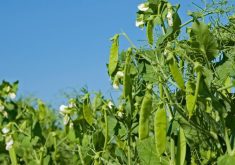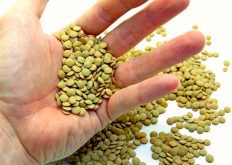CNS Canada –– Chickpeas may be relatively small in terms of acreage in Western Canada, but the quality aspects of the country’s crop, especially the larger-calibre varieties, may help command some premiums in the global market.
Canadian farmers intend to plant 140,000 acres of chickpeas in 2015, down from the 170,000 seeded the previous year and well off the highs of the “chickpea boom” of the early 2000s, according to Statistics Canada data.
Recent production problems in India are helping fuel a turn higher in all pulse markets, including chickpeas, but large offerings out of Russia and Argentina are also being seen, said Colin Young of Midwest Investments at Moose Jaw, Sask.
Read Also

U.S. livestock: Cattle mixed on technicals, profit taking after tight supply rally
Chicago | Reuters – Chicago Mercantile Exchange cattle futures ended mixed on Wednesday as tight supplies and higher choice beef…
Canada is looking to market a premium-quality product at a premium price, said Young. However, that price will be relative to the opportunities presented in the global market, as Canadian production is not large enough to have a significant impact on world supply/demand fundamentals.
Russia and Argentina have both increased production of low-quality small-calibre chickpeas, but Canadian chickpeas are finding their own niche based on quality. As a result, with the help of dedicated marketing, Young said Canadian chickpeas were seeing a modest appreciation in value.
Grower bids of 28 to 33 cents per pound on nine- and 10-millimetre Kabulis have risen slightly in recent months, while the eight-millimetre supplies have seen an even larger increase.
The narrowing in of that spread is supportive for the larger-calibre, higher-quality product.
Young likened it to buying a television. A 72-inch plasma screen will always cost more than its 50-inch counterpart, but if the spread between the two narrows in enough, some customers who walked into the store looking for the smaller TV may be able to better rationalize the more expensive larger model.
The same holds true with chickpeas, as the rising smaller-calibre prices make the more expensive and higher-quality larger-calibre supplies available from Canada more attractive by comparison.
Looking ahead to marketing the 2015-16 crop, September “will tell the tale” of what sort of chickpea crop there is to move out of Canada, Young said, noting a frost-free and warm September would be critical.
Furthering the TV analogy, Young said that while most of the attention may be on the latest large-screen LED, there are also still people out there who will buy a 17-inch tube set to connect to a VCR.
“There is a market for every quality,” he said, adding that even off-grade chickpeas will find a home.
— Phil Franz-Warkentin writes for Commodity News Service Canada, a Winnipeg company specializing in grain and commodity market reporting.

















